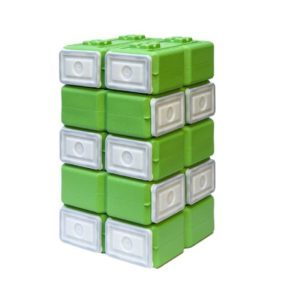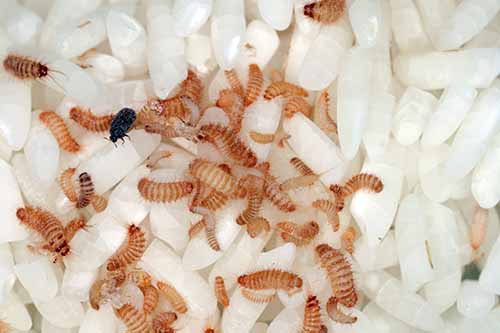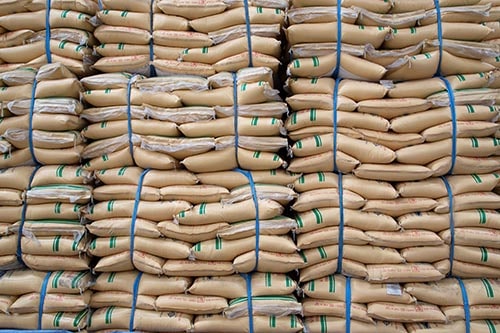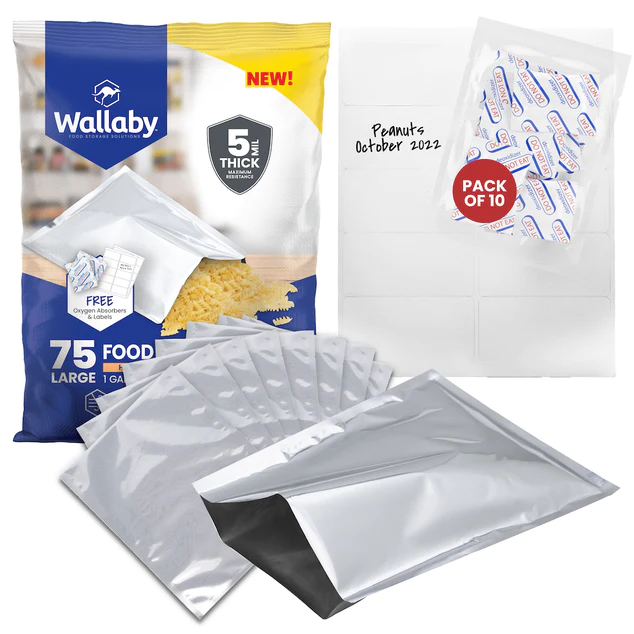White rice is non-perishable and can last for 30+ years without going bad. Brown rice can last for upwards of 5 years without going bad. But even “non-perishables” can go bad if they aren’t stored correctly.
If you want your rice to last for years, you’ll need to store it in the proper containers. This means containers that keep out moisture, oxygen, and pests.
Below are the best rice storage containers, including options for bulk rice storage, smaller containers, and options for storing rice on a budget.
If you are new to bulk storage, I recommend reading how to store rice long-term.
Best Bulk Rice Storage Containers
Below are the best containers for storing rice in bulk for long periods.
Mylar Bags – best option for long-term storage
Mylar bags are considered the best way to store dry foods long-term. Once sealed, they do not let any air or moisture through. Ideally, you will also put an oxygen absorber (OA) in with the rice.
The OA removes oxygen from inside the packaging. Without oxygen, nutrients in the rice don’t break down, and fats don’t go rancid as quickly. Pests like moths also can’t survive without oxygen.
Stored this way, white rice will last 10-30 years, and brown rice will last 2-5 years.
Pros:
- Completely airtight
- Don’t let moisture or light through
- Affordable
- Come in many sizes
Cons:
- Need to be sealed
- Can’t see contents
- Have a learning curve
Buckets with Gamma Lids – best for bulk rice storage (rotate within 1-2 years)
Buckets are great if you want to store large amounts of rice but don’t want to bother sealing Mylar bags. You can dump the rice into the bucket and put a lid on it. A 5-gallon bucket will hold approximately 36lbs of rice.
It’s vital that you only use food-grade buckets for storing rice. You also want to have good lids for the buckets. I recommend gamma lids. They create an airtight seal. You can use oxygen absorbers in the buckets to prevent pest eggs from hatching. These lids also make it much easier to open and close the buckets.
Over time, the lids’ seal can dry out and crack. Air will leak in (making the oxygen absorber useless), and pests might get inside too. So, buckets are only good as rice storage containers if you rotate through them within 1-2 years.
Pros:
- Hold large amounts of rice
- Affordable
- Easy solution
Cons:
- Might not be able to rotate through the rice fast enough
- Seals aren’t reliably airtight
Wide Mouth Mason Jars with Two-Part Lids – Best for storing smaller amounts of rice (rotate regularly)
An easy rice storage solution is to pour the rice into glass mason jars. The ones with two-part lids create an airtight seal. Jars with gasket lids also work, but the seal isn’t as reliable as two-part lids.
You can put oxygen absorbers in the jar, extending shelf life and protecting against pests.
I don’t like using glass for rice storage because I live in an earthquake zone. Glass could also easily break during other disasters like hurricanes or tornadoes. So, this isn’t a suitable container for storing your emergency food supply – but it is suitable for storing rice that you rotate through regularly.
Tip: If you don’t want to use oxygen absorbers, use the FoodSaver sealer kit to vacuum seal mason jars. It doesn’t remove all oxygen (read below), so OAs are still best.
Pros:
- Airtight seal
- Won’t let moisture through
- Can see contents inside
- Come in many sizes
- Affordable solution
Cons:
- Glass can break
- Seal may fail over time
Vacuum Sealer Containers – Best for storing smaller amounts of rice
It is not a good idea to store rice long-term in vacuum sealer bags (read mylar bags vs vacuum sealing).
However, vacuum sealer containers are a good solution for storing rice, especially whole-grain rice. Like any plastic container with a good seal, the containers will protect the rice from air and moisture for at least a year or two.
Unlike regular containers, though, these can be vacuum-sealed to remove air. Note that vacuum sealing does not remove all oxygen. Insect eggs could still hatch in the container. And food nutrients will still eventually deteriorate from oxidation. But vacuum sealing removes enough oxygen to slow down the process.
Because vacuum sealer containers are somewhat pricy, I wouldn’t bother storing white rice in them. However, it can help extend the shelf life of whole-grain rice. Unlike white rice, whole-grain rice has a lot of oils, which go rancid in the presence of oxygen.
The most popular brands are FoodSaver and Lasting Freshness.
Pros:
- Removes some oxygen
- Has a good seal
- Can tell if seal has broken
- Convenient sizes
Cons:
- Pricey containers
- Not suitable for bulk rice storage
- Some brands aren’t very reliable
- No large-size containers available
Rubbermaid Totes – cheap solution for bulk rice storage in dry climates
A lot of preppers store their rice in Rubbermaid tote containers. The ones made from Plastics #1, 2, 4, and 5 are food safe.
Rubbermaid has even started listing which of its products are food safe. The Brute series is particularly good for food.
You won’t get an airtight seal on a Rubbermaid tote, though, which means insects, air, and moisture can get into your rice.
Here’s a solution: Put a large piece of plastic wrap over the top of the tote. Make sure the plastic wrap extends over the edges. Then put the lid on. It’s not perfect but should work well enough if you don’t live in a humid climate.
Pros:
- Cheap solution
- Come in many sizes
- Stackable
- Durable
Cons:
- No gasket on lid
- Seal isn’t airtight
IRIS USA Pet Food Container – cheap container on wheels
This container by IRIS USA is advertised for storing pet food but is also suitable for food. It’s made from BPA-free, food-safe polypropylene plastic. This type of plastic isn’t as sturdy as HDPE but better withstands high temperatures.
The lids on the IRIS containers have gaskets, so they do a pretty good job of creating an airtight seal. It will keep pests out.
However, you can expect the container to leach some air and moisture into the rice over time. Thus, it’s best to use this for rice that you rotate through within 1-2 years. The 47-quart size will hold over 70lbs of rice.
Many brands make cheap plastic containers with gasket lids if you don’t care about wheels. Some of the best ones are Cambro, Sterilite, and Winco.
Pros:
- Cheap
- On wheels
- Comes in many sizes
Cons:
- PP plastic is not very sturdy
- Will leach air and moisture eventually
FoodBrick Containers – stackable, sturdy containers

WaterBrick is one of our top picks for long-term water storage containers. The brand also makes food storage containers which are great for rice. They come in two sizes: 3.5 gallons and 1.6 gallons. The best thing is that these containers are stackable, so you save space.
FoodBricks are made from very sturdy HDPE plastic. The lid has a gasket to make it airtight.
Like with all rubber gaskets, there is a possibility that the seal could fail over time. You can use oxygen absorbers with the FoodBricks, but you’ll need to check the container at least once a year to ensure the lid still looks “sucked down.”
Pros:
- Very sturdy and break-resistant
- Airtight and moisture-proof
- Stackable
- Convenient size
- Wide mouth
Cons:
- Containers aren’t cheap
- Seals aren’t reliably airtight
Important: Preventing Rice Pests

Many think putting rice into a sealed container will prevent pests. They don’t realize that rice already has insect eggs in it (the FDA allows a certain amount of insect fragments in rice!).
If you let the rice sit long enough – regardless of the storage container – those eggs will hatch, and you’ll end up with an infestation in your rice.

Use Oxygen Absorbers to Prevent Infestations!
Insect eggs can’t hatch without oxygen. So, if you store your rice in airtight containers (like Mylar bags or mason jars) with oxygen absorbers, you don’t have to worry about insects.
If you don’t use OAs…
Then you will need to take steps to kill the insect eggs in the rice before putting it into the storage containers. This can be done by:
- Freeze the rice for at least 3 days before storage. Let it thaw completely before putting it in containers.
- Microwaving the rice before storage. Three minutes is probably enough. After each minute, take the rice out of the microwave and stir it. Otherwise, hot spots will form in the middle and can scorch the rice.
Both of these steps are pretty annoying to do. I’d rather just store my rice with OAs to skip these steps.
For more, read:
Plastics Safe for Rice Storage
If using plastic storage containers for rice, make sure you use food-safe plastic. Otherwise, the plastic can leach chemicals into the rice.
Below are food-safe plastics:
- High-Density Polyethylene (HDPE) – the best option
- Polypropylene (PP)
- Low-Density Polyethylene (LDPE)
- Polyethylene Terephthalate (PET or PETE)
Read more about which plastics are safe for food here.








I am talking about or concerned about sweet rice flour. I am going to make “Bibingka,” a famous Filipino rice cake recipe. I have 2 boxes of sweet rice flour –they have been sitting in my pantry for over a year and haven’t touched them because I do not know how to use for anything; yet today I bumped into a show showcasing the Bibingka recipe –so, I asked my sister to show me if the rice boxes are still there. She said, “Yes.” Please tell me if the rice flour are still good and for how long. They are sealed inside a plastic bag.
If it smells fine and you don’t see any signs of spoilage (mold, for example), then it should be fine to eat. 🙂